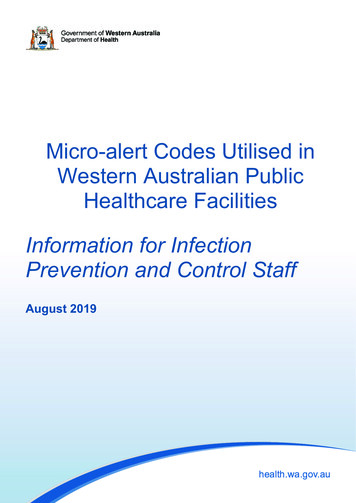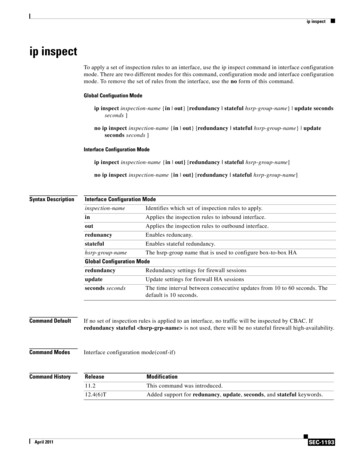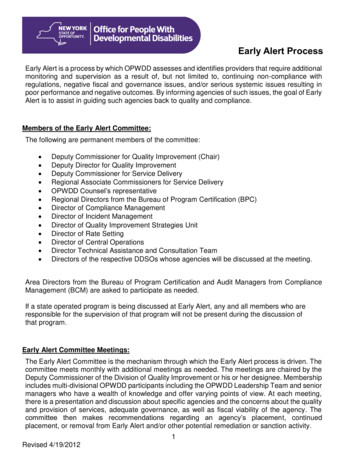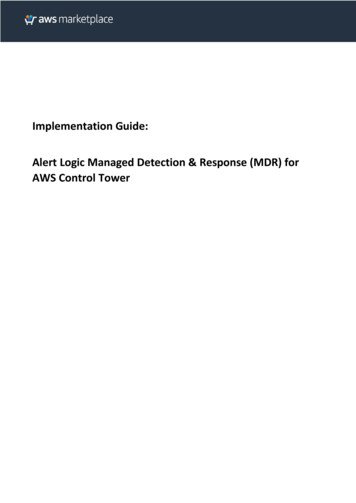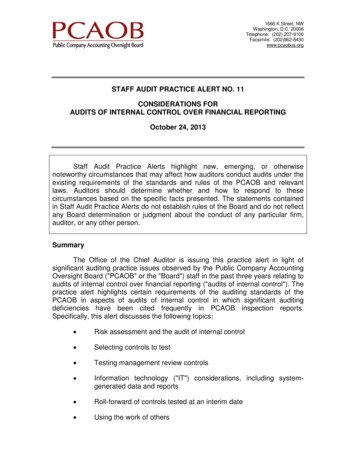
Transcription
1666 K Street, NWWashington, D.C. 20006Telephone: (202) 207-9100Facsimile: (202)862-8430www.pcaobus.orgSTAFF AUDIT PRACTICE ALERT NO. 11CONSIDERATIONS FORAUDITS OF INTERNAL CONTROL OVER FINANCIAL REPORTINGOctober 24, 2013Staff Audit Practice Alerts highlight new, emerging, or otherwisenoteworthy circumstances that may affect how auditors conduct audits under theexisting requirements of the standards and rules of the PCAOB and relevantlaws. Auditors should determine whether and how to respond to thesecircumstances based on the specific facts presented. The statements containedin Staff Audit Practice Alerts do not establish rules of the Board and do not reflectany Board determination or judgment about the conduct of any particular firm,auditor, or any other person.SummaryThe Office of the Chief Auditor is issuing this practice alert in light ofsignificant auditing practice issues observed by the Public Company AccountingOversight Board ("PCAOB" or the "Board") staff in the past three years relating toaudits of internal control over financial reporting ("audits of internal control"). Thepractice alert highlights certain requirements of the auditing standards of thePCAOB in aspects of audits of internal control in which significant auditingdeficiencies have been cited frequently in PCAOB inspection reports.Specifically, this alert discusses the following topics: Risk assessment and the audit of internal control Selecting controls to test Testing management review controls Information technology ("IT") considerations, including systemgenerated data and reports Roll-forward of controls tested at an interim date Using the work of others
Staff Audit Practice Alert No. 11October 24, 2013Page 2 Evaluating identified control deficienciesAuditors should take note of the matters discussed in this alert in planningand performing their audits of internal control. Because of the nature andimportance of the matters covered in this alert, it is particularly important for theengagement partner and senior engagement team members to focus on theseareas and for engagement quality reviewers to keep these matters in mind whenperforming their engagement quality reviews. Auditing firms also should considerwhether additional training of their auditing personnel is needed for the topicsdiscussed in this alert.Audit committees of companies for which audits of internal control areconducted might wish to discuss with their auditors the level of auditingdeficiencies in this area identified in their auditors' internal inspections andPCAOB inspections, request information from their auditors about potential rootcauses of such findings, and ask how they are addressing the matters discussedin this alert. In particular, audit committees may want to inquire about theinvolvement and focus by senior members of the firm on these matters.
Staff Audit Practice Alert No. 11October 24, 2013Page 3IntroductionEffective internal control over financial reporting ("internal control") helpsassure that companies produce reliable published financial statements thatinvestors can use in making investment decisions. Since the 1970s, federal lawshave required public companies to maintain sufficient "internal accountingcontrols." 1/ The Sarbanes-Oxley Act of 2002, as amended, ("Act") requirescompany management to annually assess and report on the effectiveness of thecompany's internal control. For larger companies, the Act also requiresindependent auditors to attest to management's assessment of the effectivenessof the company's internal control. 2/Auditing Standard No. 5, An Audit of Internal Control Over FinancialReporting That Is Integrated with An Audit of Financial Statements, establishesrequirements for performing and reporting on audits of internal control. The auditof internal control should be integrated with the audit of the financial statements.The objectives of the audits are not identical, and the auditor must plan andperform the work to achieve the objectives of both audits. In reporting on anintegrated audit of internal control and financial statements ("integrated audit"),the auditor expresses an opinion on the financial statements and an opinion onthe effectiveness of the company's internal control.1/See 15 U.S.C. 78m, which was added to federal securities law bythe Foreign Corrupt Practices Act of 1977, which sets forth requirements fordevising and maintaining a "system of internal accounting controls" sufficient toprovide reasonable assurance that, among other things, transactions arerecorded as necessary to permit preparation of financial statements in conformitywith generally accepted accounting principles or any other applicable criteria.2/See § 404 of the Act. The auditor attestation requirement applies tocompanies that qualify as "large accelerated filers" or "accelerated filers," otherthan "emerging growth companies." Pursuant to 17 C.F.R. § 240.12b-2, thedesignation of accelerated filers and large accelerated filers is based on, amongother things, the aggregate worldwide market value of the voting and non-votingcommon equity held by non-affiliates as of the last business day of the issuer'smost recently completed second fiscal quarter. For an accelerated filer, theaggregate market value criterion is 75 million or more, but less than 700million. For a large accelerated filer, the aggregate market value criterion is 700million or more.
Staff Audit Practice Alert No. 11October 24, 2013Page 4Auditing Standard No. 5 establishes a top-down, 3/ risk-based approach tothe audit of internal control. The auditing standard is designed to focus auditorson the most important matters in the audit of internal control and avoidprocedures that are unnecessary to an effective audit.When Auditing Standard No. 5 was adopted, the Board announced itsintention to monitor the implementation of that auditing standard. The PCAOBhas continued to monitor Auditing Standard No. 5 execution as part of its ongoingoversight activities. Over the last three years, the PCAOB's inspections staff hasobserved a significant number of auditing deficiencies in audits of internal control.As reported in Observations from 2010 Inspections of Domestic AnnuallyInspected Firms Regarding Deficiencies in Audits of Internal Control OverFinancial Reporting ("the general inspection report"), 4/ in 46 of the 309 integratedaudit engagements (or 15 percent) covered by the general inspection report,inspections staff found that the firm, at the time it issued its audit report, hadfailed to obtain sufficient appropriate evidence to support its opinion on theeffectiveness of internal control due to one or more auditing deficienciesidentified by the inspections staff. The general inspection report also noted that,in an additional 16 percent of the engagements covered by the report, theinspections staff identified other deficiencies in the auditing of internal control thatdid not involve findings of such significance that they indicated a failure tosupport the firm's internal control opinion. 5/ Inspections in subsequent years have3/Under PCAOB standards, a top-down approach begins at thefinancial statement level and with the auditor's understanding of the overall risksto internal control over financial reporting. The auditor then focuses on entitylevel controls and works down to significant accounts and disclosures and theirrelevant assertions. This approach directs the auditor's attention to accounts,disclosures, and assertions that present a reasonable possibility of materialmisstatement to the financial statements and related disclosures. The auditorthen verifies his or her understanding of the risks in the company's processesand selects for testing those controls that sufficiently address the assessed riskof misstatement to each relevant assertion. See paragraph 21 of AuditingStandard No. 5.4/See PCAOB Release 2012-006, Observations from 2010Inspections of Domestic Annually Inspected Firms Regarding Deficiencies inAudits of Internal Control Over Financial Reporting (December 10, 2012).
Staff Audit Practice Alert No. 11October 24, 2013Page 5continued to identify similarly high levels of deficiencies in audits of internalcontrol.Deficiencies in audits of internal control also can affect the audit of thefinancial statements. In integrated audits, auditors often rely on controls toreduce their substantive testing of financial statement accounts and disclosures.Thus, deficiencies in testing and evaluating internal control can lead toinadequate testing of accounts and disclosures in the financial statement audit.The general inspection report notes that, in 39 of the 46 engagements (85percent) in which the inspection staff found that the firm did not have sufficientappropriate evidence to support the firm's internal control opinion, representing13 percent of the 309 integrated audit engagements that were inspected,inspection staff found that the firm also failed to obtain sufficient appropriateevidence to support its opinion on the financial statements.Significant auditing deficiencies in audits of internal control that have beenfrequently cited in PCAOB inspection reports include failures to: Identify and sufficiently test controls that are intended to addressthe risks of material misstatement; Sufficiently test the design and operating effectiveness ofmanagement review controls that are used to monitor the results ofoperations; Obtain sufficient evidence to update the results of testing ofcontrols from an interim date to the company's year end (i.e., theroll-forward period); Sufficiently test controls over the system-generated data andreports that support important controls; 65/Although the general inspection report relates to inspections ofeight domestic registered firms that have been inspected annually since theinception of the PCAOB inspections program, as the report states, PCAOBinspections have found similar problems with audits of internal control at otherregistered firms.6/See paragraph 39 of Auditing Standard No. 5, which provides thatthe auditor should test those controls that are important to the auditor's
Staff Audit Practice Alert No. 11October 24, 2013Page 6 Sufficiently perform procedures regarding the use of the work ofothers; and Sufficiently evaluate identified control deficiencies. 7/This practice alert discusses the application of certain requirements ofAuditing Standard No. 5 and other PCAOB standards to specific aspects of theaudit of internal control in light of recent observations of auditing deficiencies.Specifically, this alert discusses the following topics: Risk assessment and the audit of internal control. This alertexplains how the risk assessment process set forth in PCAOBstandards relates to certain aspects of the audit of internal control.It also discusses coordinating the procedures for obtaining anunderstanding of internal control with the Auditing Standard No. 5objectives for understanding likely sources of misstatement,assessing risks for components of significant accounts anddisclosures, and considering risk in determining the scope of testingin multi-location engagements. Selecting controls to test. The alert discusses the requirements forselecting controls to test and considerations for making anappropriate selection of controls to test, including controls thatoperate infrequently. Testing management review controls. The alert discussesmanagement review controls and the requirements in PCAOBstandards for testing those controls. Information technology ("IT") considerations, including systemgenerated data and reports. The alert highlights requirements inPCAOB standards regarding the consideration of IT in audits ofinternal control, including testing controls that use system-conclusion about whether the company's controls sufficiently address theassessed risk of misstatement to each relevant assertion.7/See, e.g., PCAOB Release 2012-006, Observations from 2010Inspections of Domestic Annually Inspected Firms Regarding Deficiencies inAudits of Internal Control Over Financial Reporting (December 10, 2012).
Staff Audit Practice Alert No. 11October 24, 2013Page 7generated data and reports and evaluating deficiencies in ITgeneral controls ("ITGCs"). Roll-forward of controls tested at an interim date. The alertdiscusses the auditor's responsibilities when controls are tested atan interim date in the audit of internal control, including thenecessary roll-forward procedures to extend the results of interimtesting to year end. Using the work of others. The alert discusses the requirements inPCAOB standards regarding when it is appropriate to use the workof others, how to determine the extent to which the work can beused, and the importance of testing the work of others. Evaluating identified control deficiencies. The alert discusses theauditor's responsibilities for evaluating control deficiencies andhighlights the importance of testing compensating controls andperforming the evaluation with professional skepticism and carefulanalysis.Risk Assessment and the Audit of Internal ControlOne of the potential root causes for the deficiencies in audits of internalcontrol, as cited in the general inspection report, is improper application of thetop-down approach set forth in PCAOB standards. 8/ For example, the generalinspection report notes that, in some instances, it appears that firms, inimplementing a top-down approach, placed undue emphasis on testingmanagement review controls and other detective controls without consideringwhether they adequately addressed the assessed risks of material misstatementof the significant account or disclosure. In some instances, inspections staffobserved that firms failed to test controls for all relevant assertions of thesignificant accounts and disclosures. In other instances, it appeared to theinspections staff that firms did not sufficiently understand the likely sources of8/See paragraph 21 of Auditing Standard No. 5. Also, the generalinspection report notes that the improper application of the top-down approachmay be caused, in part, by other root causes discussed in that report and areduced focus by firms on the requirements of Auditing Standard No. 5. See thegeneral inspection report at 18.
Staff Audit Practice Alert No. 11October 24, 2013Page 8potential misstatements related to significant accounts or disclosures as part ofselecting controls to test.Risk assessment is a key element of the top-down approach, and itunderlies the entire audit process in the audit of internal control. 9/ An effectiverisk assessment process pursuant to PCAOB standards is fundamental to theaudit of internal control. 10/ Identifying the risks of material misstatement –including the types of potential misstatements that can occur and the likelysources of those potential misstatements – is necessary for the auditor to selectappropriate controls to test and to evaluate whether those controls adequatelyaddress the risks. For example, an auditor who identifies revenue overstatementas a risk, without assessing how overstatements might occur or understandingthe controls in place to address the risk, lacks the basis to make an informedselection of controls to test or to meaningfully evaluate whether the selectedcontrols are designed and operating to prevent or detect potential misstatements.Auditing Standard No. 5 requires a risk-based audit approach. Properapplication of the auditing standards for assessing and responding to risk ("riskassessment standards") 11/ is important for performing effective audits of internalcontrol and integrating the audit of internal control with the audit of financialstatements.Auditing Standard No. 12, Identifying and Assessing Risks of MaterialMisstatement, establishes a process for identifying and assessing risks ofmaterial misstatement in an audit, which applies to audits of internal control andaudits of financial statements. The risk assessment procedures required byAuditing Standard No. 12 include, among other things, obtaining anunderstanding of the company and its environment and obtaining anunderstanding of internal control. The auditing standard also sets forth a processfor assessing identified risks, which includes determining the likely sources of9/See paragraph 10 of Auditing Standard No. 5. Also, see generally,Auditing Standard No. 8, Audit Risk, Auditing Standard No.12, Identifying andAssessing Risks of Material Misstatement, and Auditing Standard No. 13, TheAuditor's Responses to the Risks of Material Misstatement.10/See paragraph 6 of Auditing Standard No. 12 and paragraphs 6and 10 of Auditing Standard No. 5.11/Auditing Standard Nos. 8-15.
Staff Audit Practice Alert No. 11October 24, 2013Page 9potential misstatement and evaluating the types of misstatements that couldresult from the risks; the accounts, disclosures, and assertions that could beaffected; and the likelihood and magnitude of potential misstatements. 12/Obtaining an Understanding of Internal ControlIn an audit of internal control, a thorough understanding of the company'sinternal control is important because it enables the auditor to appropriately planand perform the necessary tests of controls. Auditing Standard No. 12 requiresthe auditor to obtain a sufficient understanding of each component 13/ of internalcontrol to (1) identify the types of potential misstatements, (2) assess the factorsthat affect the risks of material misstatement, and (3) design tests of controls andsubstantive procedures. 14/Understanding internal control includes understanding the informationsystem, including the related business processes, relevant to financial reporting,which comprise the following:a.The classes of transactions in the company's operations that aresignificant to the financial statements;b.The procedures, within both automated and manual systems, bywhich those transactions are initiated, authorized, processed,recorded, and reported;c.The related accounting records, supporting information, andspecific accounts in the financial statements that are used toinitiate, authorize, process, and record transactions;12/See paragraphs 59 and 61 of Auditing Standard No. 12.13/Paragraph 21 of Auditing Standard No. 12 provides that internalcontrol can be described as consisting of the following components: the controlenvironment, company's risk assessment process, information andcommunication, control activities, and monitoring of controls.14/See paragraph 18 of Auditing Standard No. 12 and paragraph 13 ofAuditing Standard No. 15, Audit Evidence.
Staff Audit Practice Alert No. 11October 24, 2013Page 10d.How the information system captures events and conditions, otherthan transactions, that are significant to the financial statements;ande.The period-end financial reporting process. 15/In an audit of internal control, Auditing Standard No. 5 requires the auditorto perform procedures to achieve certain objectives for further understandinglikely sources of potential misstatements and as part of selecting controls totest. 16/ The procedures performed to achieve those objectives may be performedconcurrently with procedures for identifying and assessing risks of materialmisstatement pursuant to Auditing Standard No. 12. Performing the proceduresconcurrently could facilitate compliance with PCAOB standards, enhance theauditor's understanding of the company's processes and likely sources ofpotential misstatements, and avoid potential duplication of audit effort.The following table illustrates how certain of the procedures required byAuditing Standard No. 12 can be coordinated with the procedures applied tomeet certain of the Auditing Standard No. 5 objectives. For example, whileobtaining an understanding of the information system pursuant to AuditingStandard No. 12, the auditor also can perform procedures to understand the flowof transactions for relevant assertions. Similarly, while obtaining anunderstanding of the company's risk assessment process and control activities,the auditor also can identify the controls that management has implemented toaddress potential misstatements.15/See paragraph 28 of Auditing Standard No. 12.16/See paragraph 34 of Auditing Standard No. 5.
Staff Audit Practice Alert No. 11October 24, 2013Page 11Procedures Required by AuditingStandard No. 12Related Objective in AuditingStandardNo. 5 17/Obtain an understanding of theinformation system, including therelated business processes, relevant tofinancial reporting 18/Understand the flow of transactionsrelated to the relevant assertions,including how these transactions areinitiated, authorized, processed, andrecordedIdentify and assess the risks of materialmisstatement at the assertion level andidentify significant accounts anddisclosuresandtheirrelevant19/assertionsVerify that the auditor has identified thepoints within the company's processesat which a misstatement – including amisstatement due to fraud – could arisethat, individually or in combination withother misstatements, would be materialObtain an understanding of thecompany's risk assessment processand 20/ control activities, 21/ and considercontrols that address fraud risks andother significant risks 22/Identify the controls that managementhas implemented to address thepotential misstatementsIdentify the controls that managementhas implemented over the preventionor timely detection of unauthorizedacquisition, use, or disposition of thecompany's assets that could result in amaterial misstatement of the financialstatements17/Id.18/See paragraph 28 of Auditing Standard No. 12.19/See paragraphs 59-64 of Auditing Standard No. 12.20/See paragraphs 26-27 of Auditing Standard No. 12.21/See paragraph 34 of Auditing Standard No. 12.22/See paragraphs 72-73 of Auditing Standard No. 12.
Staff Audit Practice Alert No. 11October 24, 2013Page 12Auditing Standard No. 5 and Auditing Standard No. 12 provide that,although walkthroughs are not required, performing walkthroughs thatencompass the procedures set forth in the standard 23/ is an effective way to meetthe required Auditing Standard No. 5 objectives in the table above and may beused in testing the design of controls. 24/ Thus, careful planning and execution ofwalkthroughs, particularly when performed or supervised by experiencedpersonnel, can enhance the effectiveness of those aspects of the integrated auditand avoid duplication of effort. Incomplete or poorly executed walkthroughs,however, can lead to inadequate risk assessments, which can impair theeffectiveness of auditors' selection and testing of controls.The general inspection report notes that, in some situations, firms'walkthrough procedures were not adequate to verify the auditor's understandingof the risks in the company's processes and to identify and select for testingcontrols sufficient to address the risk of misstatement for the relevant assertions,as they were limited to: Performing inquiry and observation to confirm that there have beenno significant changes to the processes; Obtaining an understandingsubstantive procedures; Reviewing walkthroughs performed by the company's internalauditor who did not provide direct assistance under the firm'ssupervision; orthroughcontrolstestingand23/Paragraph 37 of Auditing Standard No. 5 provides that, inperforming a walkthrough, the auditor follows a transaction from originationthrough the company's processes, including information systems, until it isreflected in the company's financial records, using the same documents andinformation technology that company personnel use. Walkthrough proceduresusually include a combination of inquiry, observation, inspection of relevantdocumentation, and re-performance of controls.24/See paragraphs 37-38 and 43 of Auditing Standard No. 5,paragraphs 20 and 37-38 of Auditing Standard No. 12, and paragraph 20 ofAuditing Standard No. 13.
Staff Audit Practice Alert No. 11October 24, 2013Page 13 Relying on the auditor's knowledge and experience obtained fromprior years' audits.Assessing Risks of Material Misstatement in Components of Significant Accountsand DisclosuresIn assessing risks of material misstatement and selecting controls to test,it is important for auditors to be aware that the components of a potentialsignificant account or disclosure might be subject to significantly different risks. 25/Also, different risks of material misstatement affecting the same assertion of anaccount or disclosure might arise at different points within the company'sprocesses. If risks differ among components, the auditor might need to selectand test different controls to support a conclusion that the controls adequatelyaddress the risks to the account or disclosure.The following are some examples of accounts and disclosures for whichindividual components could have different risks: Individual revenue categories might have different risks because ofvarying types of products and services, sales terms, informationsystems, including revenue processes, or accounting requirements. Individual investment securities or categories of securities in aportfolio might have different risks if they vary in nature andcomplexity, level of market activity, or availability of observablemarket data. The components of an allowance for loan losses might havedifferent risks, for instance, if those components reflect differentcredit exposures, are determined using different methods, or aresubject to different accounting requirements. The components of a reserve for sales returns and allowancesmight have different risks if they relate to different sales terms orrepayment terms, use different information systems, includingbusiness processes, or are subject to different accountingrequirements.25/See paragraph 63 of Auditing Standard No. 12.
Staff Audit Practice Alert No. 11October 24, 2013Page 14Effect of Risk Assessment on the Scope of Testing in Multi-locationEngagementsInspections staff have observed instances, such as the following, in whichit appeared that firms did not sufficiently test controls that addressed the risks ofmaterial misstatement in multi-location engagements: Testing a sample of locations and extrapolating the results of thattesting to other locations without performing procedures to evaluatewhether the issuers' systems and controls were designed andimplemented consistently across all of those locations. Excluding certain locations from testing without establishingwhether there was a reasonable basis for excluding thoselocations.Also, inspections staff have observed instances in which it appeared thatfirms, in implementing a top-down approach, placed undue emphasis on testingmanagement review controls and other detective controls without consideringwhether the controls selected for testing, individually or in combination,adequately addressed the assessed risks of material misstatement of thesignificant account or disclosure across the significant locations.In multi-location engagements, PCAOB standards require the auditor toassess the risks of material misstatement to the consolidated financialstatements associated with the location or business unit and correlate theamount of auditing attention devoted to the location or business unit with thedegree of risk. 26/ Auditing Standard No. 9 lists factors that are relevant to theassessment of the risk of material misstatement associated with a location orbusiness unit and the determination of the necessary audit procedures. 27/ Certainof the factors listed in Auditing Standard No. 9 relate to the inherent risks ofmaterial misstatement, while others – such as the control environment,centralized processing, and monitoring activities – relate to entity-level controls.Auditing Standard No. 5 provides that, in lower risk locations, the auditor mightfirst evaluate whether entity-level controls, including controls in place to provide26/See paragraph 11 of Auditing Standard No. 9, Audit Planning, andparagraph B10 of Auditing Standard No. 5.27/See paragraph 12 of Auditing Standard No. 9.
Staff Audit Practice Alert No. 11October 24, 2013Page 15assurance that appropriate controls exist throughout the organization, provide theauditor with sufficient evidence. 28/ Auditing Standard No. 5 also provides that theauditor may take into account the work of others in determining the locations orbusiness units at which to perform tests of controls. 29/ Using the work of others isdiscussed later in this alert.To illustrate the application of these principles, assume that an auditor isperforming an integrated audit of a company with business units in severallocations. After assessing the risks associated with the individual locations, anauditor might design an audit strategy involving:a.Identifying and testing controls over specific risks that present areasonable possibility of material misstatement to the company'sconsolidated financial statements;b.To the extent not covered in item a above, identifying and testingcontrols at locations or business units that, individually or incombination, present a reasonable possibility of materialmisstatement through one or more of the following:(1)Testing entity-level controls that operate at a level ofprecision that would detect material misstatements in thelocations or business units, individually or in combination.(2)For locations with centralized systems and processes andhomogeneous controls, performing tests of the commoncontrols across the locations or business units.(3)Using the work of others who tested controls at the locations,to the extent appropriate, as discussed later in this release.c.No specific testing of controls for locations or business units thatindividually or in combination do not present a reasonablepossibility of material misstatement of the consolidated financialstatements.28/See paragraph B11 of Auditing Standard No. 5.29/See paragraph B12 of Auditing Standard No. 5.
Staff Audit Practice Alert No. 11October 24, 2013Page 16In testing controls at location
October 24, 2013 Page 5 continued to identify similarly high of deficiencies in audits of internal levels control. Deficiencies in audits of internal control also can affect the audit of the financial statements. In integrated audits, auditors often rely on controls to reduce their substantive testing of financial statement accounts and .


